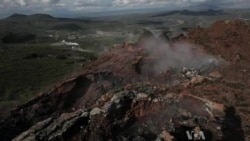NAIROBI —
With Kenya's proximity to the Great Rift, once a hotbed of volcanic activity, the country is the biggest producer of geothermal energy on the continent. Currently 13 percent of the national grid is powered by this renewable energy, but untapped geothermal fields have the potential to cover all of Kenya's power needs, and then some.
Near the Kenyan town of Naivasha, Isaac Kirimi treks up a steaming hillside. Kirimi is a drilling superintendent with KenGen, Kenya’s leading power company.
“This is like a live volcano! You can easily convince someone you’re in hell,” he said.
The rocks underfoot are still soft. He looks for a small bushy plant known as geothermal grass, which thrives in high ground temperatures.
“It is normally used by scientists to give them an indication of where there is potential for geothermal resources,” said Kirimi. "A scientist is like a wild person. You are imagining things and now trying to transfer that imagination. And try to convince someone to invest in that is not very easy."
Investing in renewable energy
Today, more than 30 years after KenGen built its first geothermal plant in the area, investment in renewable energy is booming. KenGen, with government support, is ramping up geothermal production.
"The cost of drilling can be prohibitive: the drilling costs, the power plant costs, and interconnecting all of these wells. Once you do that, you have nothing else to do for the next 25 years…except build another one. But we know the source is the center of the earth, so there will always be energy," said Geoffrey Muchemi, a development manager at KenGen.
For now, a majority of Kenya’s energy needs are met by hydroelectric power. But hydropower is diminished during rain shortages, leading to Kenya’s regular blackouts.
To harness geothermal energy, wells are first dug more than two kilometers into the earth’s surface.
The steam released by the wells is monitored for several months. If it's exploitable, hot water and steam are extracted from the well. The steam travels through pipes to a power plant, where it is converted into electrical energy. The water is re-injected into the earth.
Displacement fears
Near the wells, KenGen is also developing a geothermal spa. It features a large pool with mineral-rich waters, modeled after the Blue Lagoon in Iceland where many KenGen engineers studied.
But not all Kenyans support the expansion of geothermal energy.
Reuben Sempui belongs to a Masaai community on Mt. Suswa, the site of a proposed geothermal project.
"The Masaai live inside the outer crater rim. In the inner crater rim, nobody lives there," Sempui explained. "So these are the manyattas [homesteads] where the Masaai live."
Sempui’s community faces displacement if the project goes ahead. Members of the community are negotiating with KenGen, demanding employment opportunities and a share of the revenue generated by the well.
Near the Kenyan town of Naivasha, Isaac Kirimi treks up a steaming hillside. Kirimi is a drilling superintendent with KenGen, Kenya’s leading power company.
“This is like a live volcano! You can easily convince someone you’re in hell,” he said.
The rocks underfoot are still soft. He looks for a small bushy plant known as geothermal grass, which thrives in high ground temperatures.
“It is normally used by scientists to give them an indication of where there is potential for geothermal resources,” said Kirimi. "A scientist is like a wild person. You are imagining things and now trying to transfer that imagination. And try to convince someone to invest in that is not very easy."
Investing in renewable energy
Today, more than 30 years after KenGen built its first geothermal plant in the area, investment in renewable energy is booming. KenGen, with government support, is ramping up geothermal production.
"The cost of drilling can be prohibitive: the drilling costs, the power plant costs, and interconnecting all of these wells. Once you do that, you have nothing else to do for the next 25 years…except build another one. But we know the source is the center of the earth, so there will always be energy," said Geoffrey Muchemi, a development manager at KenGen.
For now, a majority of Kenya’s energy needs are met by hydroelectric power. But hydropower is diminished during rain shortages, leading to Kenya’s regular blackouts.
To harness geothermal energy, wells are first dug more than two kilometers into the earth’s surface.
The steam released by the wells is monitored for several months. If it's exploitable, hot water and steam are extracted from the well. The steam travels through pipes to a power plant, where it is converted into electrical energy. The water is re-injected into the earth.
Displacement fears
Near the wells, KenGen is also developing a geothermal spa. It features a large pool with mineral-rich waters, modeled after the Blue Lagoon in Iceland where many KenGen engineers studied.
But not all Kenyans support the expansion of geothermal energy.
Reuben Sempui belongs to a Masaai community on Mt. Suswa, the site of a proposed geothermal project.
"The Masaai live inside the outer crater rim. In the inner crater rim, nobody lives there," Sempui explained. "So these are the manyattas [homesteads] where the Masaai live."
Sempui’s community faces displacement if the project goes ahead. Members of the community are negotiating with KenGen, demanding employment opportunities and a share of the revenue generated by the well.








